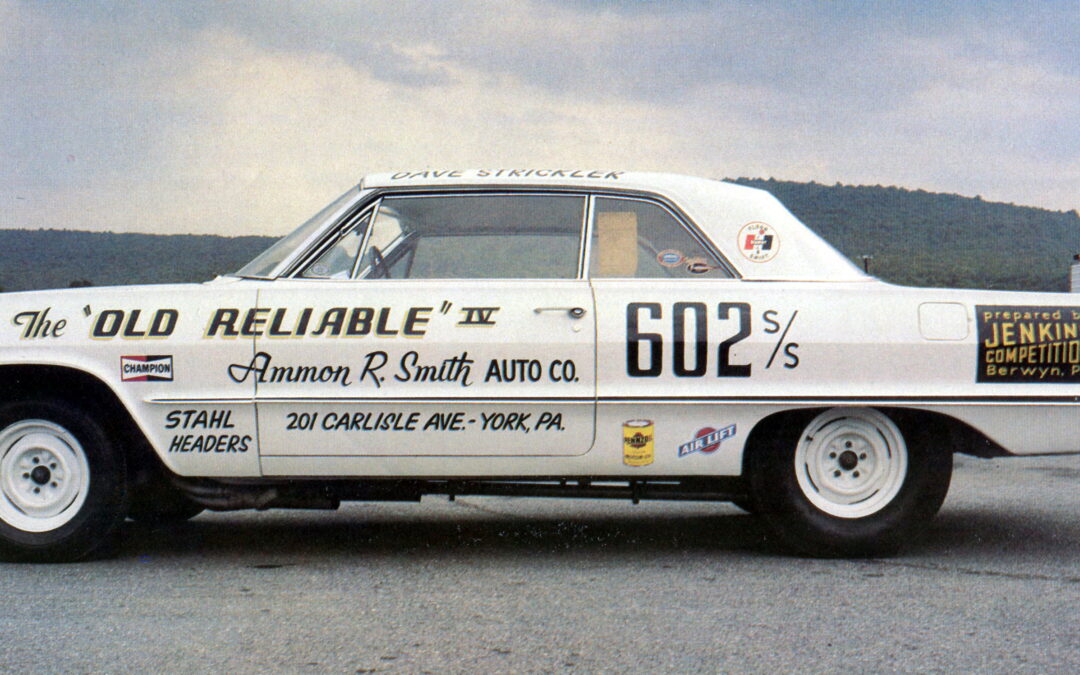We left off the story of the 409 in late 1962 with the arrival of B/FX class racers being produced at the year’s end, with hotter cammed engines, with new cylinder heads. For the 1963 model year, Chevrolet did a mild facelift of their family-sized hauler with new grille, tail ends, different bumpers and trim. The sports roof or “bubble top” as it was colloquially named was dropped for 1963. The SS package returned of course, as a big seller. New for 1963 were a couple of race engine developments; one was stillborn after the Daytona debut and the other was of limited race professional use only for NHRA. Both were 427s, but completely different engines in design and intent. The Daytona mystery motor was actually an early version of what turned out to be the 396 block with porcupine heads. Only five cars got the Mark II 427 and support from Chevrolet was cut off in February. Junior Johnson loved the power of the car, but once he ran through his stash of parts and had his shop make replacements, he was done. Johnson joined Mercury for 1964.
The other 427 was Z-11 and was in fact based on the W block with a bore increase to 4.406”. No stroking was done to achieve the cubic increase. New hardware included a two piece alloy intake manifold with matching cylinder heads to accommodate the increased height of port runners. They ran 12.5:1 pistons and as delivered from factory, pumped out 430 horsepower. Super tuning and use of proper headers got the engine into the 500 horsepower range and was capable of propelling the Chevy down the track in just 12 seconds flat @ 115 mph. Bill Jenkins prepped one of these cars for Dave Strickler, while he competed against Hayden Proffitt for the NHRA championship. It came down to the wire with a victory by Proffitt against Strickler. For the record, Strickler’s car bagged 90 percent of the 200 races during the 1963 season including “Little Eliminator at the 1963 Winternationals.” In the 1980s the same car with modern tires, cut the lights at 11 seconds @ 120 miles per hour. Chevy made fifty-nine Z-11 racers for 1963.
Meanwhile Joe Ordinary at the dealership could plunk down his cash and drive away in a 425 hp 409 Chevy. Those came with dual quad carbs, 4 speed transmission, 11:1 pistons. The next one down offered 400 horsepower using a large 4 barrel carb on intake with 11:1 compression and a four speed. The 340 hp 409 was available with Powerglide or 3 speed manual as the standard unit. It even came with a hydraulic camshaft and cast iron intake paired to small valve heads with 10:1 compression ratio. It was the consumer version of the 409. As for the SS option, it was given a new code; RPO Z03 and the dress-up items were fancier this season. A new full length console, a steering wheel with SS emblem, machine turned metal instrument panel trim, lower body side trim and SS quarter panel emblems. There were fancy hubcaps with SS emblems. The passenger grab bar disappeared though. If you wanted the tach, it was optional, but gained a new position atop the centre of the dash unless you ordered a four speed then it came standard. An extra odd touch offered that year was a vinyl top, but only for the Impala’s sport coupe and in just black or white.
Sales shot up seven percent over last year with 153,271 SS sport coupes and convertibles. However, just 21,267 409 engines went out the door in all horsepower levels. For 1964, Chevrolet was riding out the successful platform and preparing for a new chassis and body. The model therefore was one of refinements, rather than wholesale change. The grille was given a flat, drab appearance, with slab sided body panels and an equally flat tail panel. By appearances, you’d think maybe the shine was gone from Chevrolet’s full-size hauler, but you’d be mistaken. The engine might have been on the way out of passenger cars, but it lived on in other applications.
The Super Sport became actual models that year instead of just being options. There were four varieties: a six cylinder sport coupe, six cylinder convertible, V8 sport coupe and V8 convertible. The price remained the same as last year for the SS model, $161 extra over the Impala. Some interesting stuff appeared in paint and interiors that year. Goldenwood yellow was offered for two-door body styles only and demanded the all black interior, no other interior colour was accepted. Vinyl tops returned again in black or white. As for convertibles, you got white only unless you ordered black or beige and it passed by Chevrolet’s combination chart.
The SS model became distinct by trim as well with its own completely different wide spear mouldings, spinner hubcaps, emblems. Inside the bucket seats continued with opulent vinyl trim, padding and eight colour combos including two versions of two-toned dash, steering wheel and carpet sets. The console was redesigned again as well.
The 409 engines were at a standstill this year, but they did get a second 4 speed transmission choice. A new gearset with lower 2.56 first gear and lower corresponding gears and was labelled M20. A close ratio M21 unit gave you 2.20 first gear and allowed you to order a 4.11 or 4.56 posi rear axle for drag strip work. By 1964 the 409 needed every bit of help at the track. The new engines from Ford and Mopar were really hot and larger displacement as well. While it was no longer basking in the drag race glory, the aura from past victories, plus adept marketing to image conscious families netted sales of 185,325 Super Sport models. Of those, a mere 10,625 were 409 powered.
Now I bet you’re wondering just how poky a Powerglide 409 was? Well Car Life did a road test of a 1963 SS hardtop in wintertime. It was interesting to say the least. The Powerglide 340 hp version made more torque than the 425 version, partially due to camshaft duration changes and the switch to hydraulic lifters and four barrel carb. At road speeds that Joe Family Man drove, his car had more passing power than the 425 engine between 10-80 mph in high gear. It also burned rubber at will, since the 1st gear was so low. Test drivers found the power steering to be slow for the car and wished they had the metallic brakes and heavy duty springs and shocks as well. It really should have been part of the SS package all along. 0-60 mph was done in 6.6 seconds and the quarter mile came through at 15.2 seconds @ 90 mph. That’s pretty good, especially when you learn the rear axle was pegged at 3.36:1 and a California State car to boot with lazy vacuum advance curve.
Now for the tech stuff; Chevy released racing service packages as over the counter upgrades for 409 engines. The first package was actually an over the counter version of the 1961 SS option. The next service package was in 1962 and added the high lift Mark IV cam with new springs, revised single and dual quad inlet castings, improved flow cylinder heads, re-contoured ports and bigger valves. The second race service package had a Mark VI camshaft with springs, revised pistons, redesigned four barrel intake and free flowing exhaust manifolds. The Z-11 cylinder heads were “O” castings and basically race use only. We do know some 25 regular passenger cars got lightweight hoods, front fenders, bumpers and inner wheelwells, but they weren’t technically Z-11 cars. It was for testing only.
The actual 1Z11A package was 1963 only and just released for 59 race cars. A late 1962 409, modified with over the counter goodies, isn’t a real Z-11, but a “special.” By the end of 1964 a whole new era began at Chevrolet.
Enjoyed the article or have questions? Write to pa67smith@ yahoo.com.

